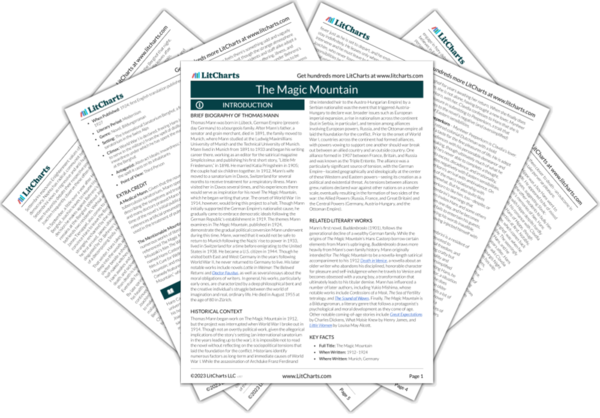Summary
Analysis
After Hans has been at the Berghof for one week, he gets a bill. It includes “medical treatment,” but Hans is fine with that, even though he didn’t seek any—it’s just part of the daily rate. He finds the fee reasonable.
That Hans is apparently fine with paying for “medical treatment” he didn’t receive—especially after he’s tried so hard this past week to convince himself that he is only visiting the Berghof, not receiving treatment as a patient—indicates his waning resistance to the allure of the sanatorium.
Themes
Later that day, Hans and Joachim discuss the management and structure of the Berghof. Director Behrens, it turns out, is not the owner of the institution—he is not an independent agent but merely acting on behalf of these more powerful forces. He came here by accident, when his sickly wife stayed here during the last few months of her life. It’s rumored that Behrens became deeply depressed after her death and seemed to lose touch with reality. After her death, he stuck around, both because he wanted to be near her grave but also because he’d become sick himself—and thus “belonged here.” The narrator, at this point, contemplates whether it’s possible for a doctor who is himself infected to be fully invested in curing others.
The detail of Behrens, the Berghof’s “director,” coming to the sanatorium to visit his sickly wife, could be a comical reference to the book’s author (and thus, its “director,” in a sense), Thomas Mann; Mann was inspired to write The Magic Mountain after visiting his wife at a sanatorium in the Swiss Alps. The detail that Behrens stuck around after getting sick himself following his wife’s death suggests that there’s something infectious about the Berghof, not only in terms of physical disease, but also the idle and decadent lifestyle the sanatorium offers.
Themes
As Hans listens to Joachim talk about Behrens’s backstory, he expresses the same doubt about Behrens as the narrator has just voiced. Joachim counters that, while there’s no way to know for sure whether Behrens is still a patient, it’s likely that he’s fully recovered by now. His children visit him sometimes, too. When his son, a university student, visited, it caused many of the women residents’ temperatures to rise and led to many dissection appointments with Krokowski.
Joachim’s remark about Behrens’s son’s visit causing the women residents’ temperatures to rise (and necessitating many dissection appointments with Krokowski) is played for comedy, but it also reinforces the link between repressed emotions and physical illness.
Themes
Krokowski holds his consultations in a private room in a part of the sanatorium that people refer to as “the basement,” though the space is not actually underground, it just looks like it is. Hans glimpses the space once and notes how dark and mysterious it appears, as though stuck in a permanent dusk—so unlike the “clinical whiteness” of the rest of the facility.
It's fitting that Krokowski holds his “dissections” in the basement, given psychoanalysis’s emphasis on unconscious, repressed drives. The darkness of the basement also creates a sense of foreboding. It doesn’t seem like an atmosphere conducive to healing and enlightenment.
Themes
Get the entire The Magic Mountain LitChart as a printable PDF.













